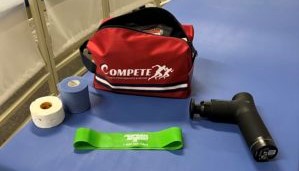From the Trainer’s Room: Olympic insights – Adapting to using a mobile training room

Due to magnitude of the Olympic Games and the number of countries participating, setting up an athletic training room can be a challenge.
Before leaving, I had to decide what I would need during the four-week journey with six Olympic figure skaters practicing up to twice a day and competing 2-3 times.
 In professional hockey, you can take 2-3 rolling cases and a few bags worth of equipment and supplies. For this trip, I had one rolling bag. I thought this would take some planning. I only knew one of the skaters, four-time Olympian and client Michal Brezina prior to leaving, so this was going to be an educated guess. I knew the medical staff for U.S. Figure Skating and Ice Hockey who would be in Beijing, so I knew if I got into a jam, they would help, which was a relief.
In professional hockey, you can take 2-3 rolling cases and a few bags worth of equipment and supplies. For this trip, I had one rolling bag. I thought this would take some planning. I only knew one of the skaters, four-time Olympian and client Michal Brezina prior to leaving, so this was going to be an educated guess. I knew the medical staff for U.S. Figure Skating and Ice Hockey who would be in Beijing, so I knew if I got into a jam, they would help, which was a relief.
As I began to order a few things and started to pack, I felt like I would miss something or not have enough of something else. The kit was full and included your typical first aid supplies and tape. For fitness and rehab, I packed various bands which we used every day even though we had a full gym both at the village and the rink.
For rehab, there was a Hyper Volt percussion massage device, Care Wear light therapy, Compex electric stim unit, and Rock Tape cupping device. I was set and ready to go.
When we first arrived at the Capital Indoor Stadium where figure skating and short track speed skating would be held, it was time to find the athletic training room or physiotherapy room. The door had a signup sheet for one of four “beds.” Upon entering, we had four training tables, each with a chair. They were all separated by drapes. Let’s just say there was barely room to move and nowhere to set up anything.
 It was strictly work out of the bag you came with and get out.
It was strictly work out of the bag you came with and get out.
The stadium has two rinks – the main rink where competitions are and a practice rink underground connected by a hallway, so this was easily accessible in a few-minute walk. This was pretty key as we occasionally had skaters on both sheets of ice around the same time. Both rinks also had their own warm up areas where I could treat when needed.
As practices began, each discipline of men, women, pairs and dance all had two practices a day. Needless to say, some days began as early as 6 a.m. and ended as late at 10 p.m. As the competitions began, the days got a little shorter, but I would guess the medical staffs averaged 14-16 hours a day at the rink to start.
Outside of the rink, we had two physiotherapy rooms in the Czech apartment building. These were much nicer and just small rooms with a massage table and a view. Either place, “Have training room, will travel” was the motto. Pack what you think you will need for the day and carry it wherever you were needed.
As the competition came to a close, I had pretty much utilized everything I brought and only ran out of some tape. Shout out to Kelsey at USFS for helping out with that. I had Iva (Czech physiotherapist) and Dr. Pilny back at the village to help with a few things as well and it couldn’t have run much smoother. In the end, pairs coach Petr Bidar posted on his social media thanking me for taking care of the skaters who had a few issues during the Games.
Though we do our jobs because we love what we do, getting that little recognition means a lot.
Chris Phillips is an athletic trainer and strength and conditioning specialist. Chris is the owner of Compete Sports Performance and Rehab in Orange County, Calif., and was in Beijing for the Olympics. He can be reached through Compete’s website at www.competeperformance.com.
(March 4, 2022)








